胡春胜1,,,
陈素英1,
王玉英1,
李晓欣1,
董文旭1,
刘秀萍1,
裴林2,
张惠3
1.中国科学院遗传与发育生物学研究所农业资源研究中心/河北省土壤生态学重点实验室/中国科学院农业水资源重点实验室 石家庄 050022
2.河北省中医药科学院 石家庄 050051
3.石家庄市栾城区农业技术推广中心 石家庄 051430
基金项目:国家重点研发计划项目(2016YFD0300808, 2016YFD0200307, 2017YFC1700703)、河北省重点研发计划项目(19226438D)和国家自然科学基金项目(41571291)资助
详细信息
作者简介:张玉铭, 主要研究方向为农田生态系统养分循环与平衡及其环境效应。E-mail: ymzhang@sjziam.ac.cn
通讯作者:胡春胜, 主要研究方向为农田生态系统碳氮循环及其环境效应。E-mail: cshu@sjziam.ac.cn
中图分类号:S153; S154.36计量
文章访问数:102
HTML全文浏览量:16
PDF下载量:53
被引次数:0
出版历程
收稿日期:2020-09-30
录用日期:2020-12-21
网络出版日期:2021-08-19
刊出日期:2021-09-06
Effects of tillage and straw returning method on the distribution of carbon and nitrogen in soil aggregates
ZHANG Yuming1,,HU Chunsheng1,,,
CHEN Suying1,
WANG Yuying1,
LI Xiaoxin1,
DONG Wenxu1,
LIU Xiuping1,
PEI Lin2,
ZHANG Hui3
1. Center for Agricultural Resources Research, Institute of Genetics and Developmental Biology, Chinese Academy of Sciences / Hebei Key Laboratory of Soil Ecology / Key Laboratory of Agricultural Water Resources, Chinese Academy of Sciences, Shijiazhuang 050022, China
2. Hebei Province Academy of Traditional Chinese Medicine, Shijiazhuang 050051, China
3. Agricultural Technology Extension Center of Luancheng District, Shijiazhuang City, Shijiazhuang 051430, China
Funds:This study was supported by the National Key Research and Development Program of China (2016YFD0300808, 2016YFD0200307, 2017YFC1700703), the Key Research and Development Program of Hebei Province (19226438D) and the National Natural Science Foundation of China (41571291)
More Information
Corresponding author:E-mail: cshu@sjziam.ac.cn
摘要
HTML全文
图
参考文献
相关文章
施引文献
资源附件
访问统计
摘要
摘要:华北平原是我国主要的粮食生产基地之一, 小麦-玉米轮作是本区域主要种植模式。长期秸秆全量还田与土壤的浅旋耕造成了土壤耕层变浅、犁底层加厚、养分表聚等一系列土壤质量问题, 已成为制约本区域粮食持续高产、稳产的障碍因素。本研究依托中国科学院栾城农业生态系统试验站转变耕作与秸秆还田方式定位试验, 开展不同耕作措施和秸秆还田方式对土壤团聚体组成及其稳定性、有机碳氮在团聚体中分布影响的研究, 为阐释不同农业管理措施下土壤碳氮的物理保护机制提供依据。试验设5个处理: 无秸秆旋耕(对照1)、秸秆旋耕还田(对照2)、秸秆深翻耕还田、秸秆集中深混埋、秸秆集中深埋, 后3个处理作为转变秸秆还田方式处理。研究结果表明, 改变秸秆旋耕还田为深层还田可以显著提高粒径>0.25 mm团聚体含量; 不同秸秆还田方式对>2 mm的大团聚体和0.25~2 mm的小团聚体的水稳性影响存在较大差异, 秸秆深层还田主要增加10 cm以下土层土壤水稳性大团聚体(>2 mm)含量和表层水稳性小团聚体(0.25~2 mm)含量, 大团聚体和小团聚体的水稳性消长受到了秸秆还田方式的影响。秸秆深层还田显著增加了亚耕层(20~40 cm)土壤团聚体稳定率, 降低了其结构破碎率。秸秆深层还田措施使0~40 cm土层土壤有效融合, 消除了耕层土壤养分表聚现象, 显著增加了亚耕层土壤有机碳氮含量以及大团聚体对土壤有机碳氮的贡献率, >2 mm团聚体有机碳和氮贡献率在20~40 cm土层分别平均为42.2%~44.0%和32.8%~49.9%, 分别比秸秆旋耕还田处理增加48.7%~54.9%和32.8%~101.8%。总之, 秸秆深层还田有利于改善耕层土壤结构, 促进土壤有效融合, 消除土壤表聚现象。
关键词:耕作/
秸秆还田/
有机碳/
氮素/
土壤团聚体
Abstract:The North China Plain is a major grain production area in China, and wheat-maize rotation is the main cropping pattern in this region. Long-term straw returning and shallow rotary tillage have caused soil quality problems, such as a shallow plow soil layer, thickening of the plow bottom, and nutrient accumulation at the soil surface. These problems restrict a sustainable and stable grain yield. This study examined the effects of different agricultural management practices of tillage measures and methods of straw returning of physical protection on the soil aggregate composition and stability, the distribution of organic carbon and nitrogen in the aggregates at the Luancheng Agricultural Ecosystem Experimental Station, Chinese Academy of Sciences. A tillage and straw counters-field positioning experiment was conducted from 2016 with five treatments: no-straw and rotary tillage (as control 1, RT), straw mulching and rotary tillage (as control 2, SR), straw mulching and deep ploughing (SP), straw incorporated into 0?40 cm soil layer of 40 wild no-wheat planting belt (SID), and straw buried into 30?40 cm soil layer (SBD). The three latter treatments represented different straw returning methods. The results showed that changing rotary tillage to deep tillage under straw returning significantly increased the content of large macroaggregates (>0.25 mm). Different straw returning methods led to significantly different changes in water stability of the large (>2 mm) and small (0.25–2 mm) macroaggregates. Straw returning to the deep soil layer increased the content of large water-stable macroaggregates in soil layers below 10 cm (>2 mm), whereas increased the content of small water-stable macroaggregates (0.25–2 mm) in the surface layer. The changes in the water stability of large and small macroaggregates were impacted by the straw returning method. Straw returning to deep soil layer significantly increased the stability in the subsurface layer (20–40 cm) and decreased the structural fragmentation rate of soil aggregates. Deep straw returning effectively integrated the 0–40 cm soil layer, eliminated the surface accumulation of nutrients, and significantly increased the soil organic carbon and nitrogen contents in the subsurface layer and the contribution of large macroaggregates to soil organic carbon and nitrogen. The contribution of organic carbon and nitrogen of the macroaggregates (>2 mm) in the 20–40 cm soil layer was 42.2%–44.0% and 32.8%–49.9%, respectively, which increased by 48.7%–54.9% and 32.8%–101.8%, respectively, compared to straw-free rotary tillage. In summary, the straw returning to deep soil layer improved soil structure of tillage layer, promoted integration of soil layers and emilimated nutrient accumulation in soil surface layer.
Key words:Tillage/
Straw returning/
Organic carbon/
Nitrogen/
Soil aggregate
HTML全文
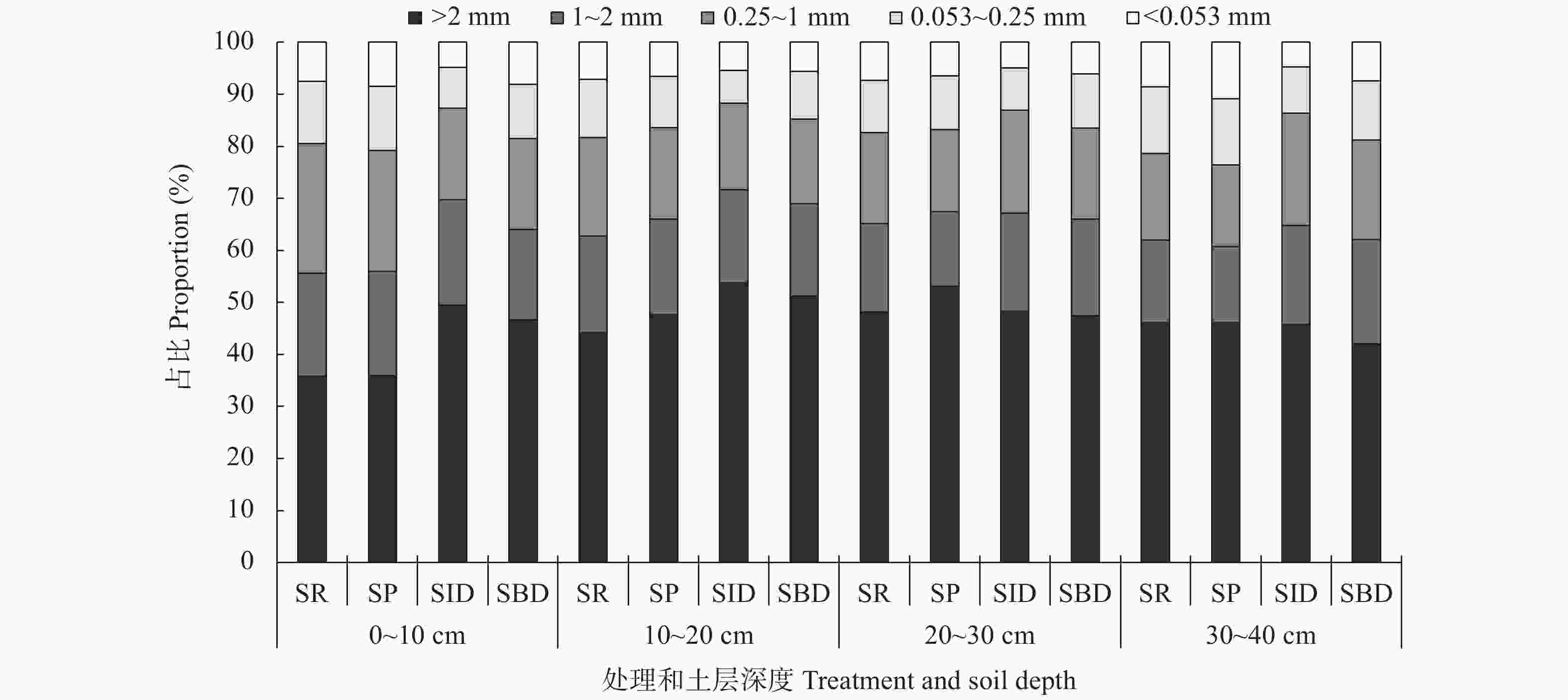
图1耕作与秸秆还田方式对土壤机械稳定性团聚体组成的影响
SR: 秸秆还田、土壤旋耕; SP: 秸秆还田、土壤深耕; SID: 秸秆集中深混埋至非种植带(40 cm宽)的0~40 cm土层; SBD: 秸秆集中深埋至30~40 cm土层。SR: straw mulching and rotary tillage; SP: straw mulching and deep ploughing; SID: straw incorporated into 0?40 cm layer of 40 cm wide no-wheat planting belt; SBD: straw buried into 30?40 cm soil layer.
Figure1.Effects of tillage and straw returning methods on the composition of soil mechanically stable aggregates
 下载: 全尺寸图片幻灯片
下载: 全尺寸图片幻灯片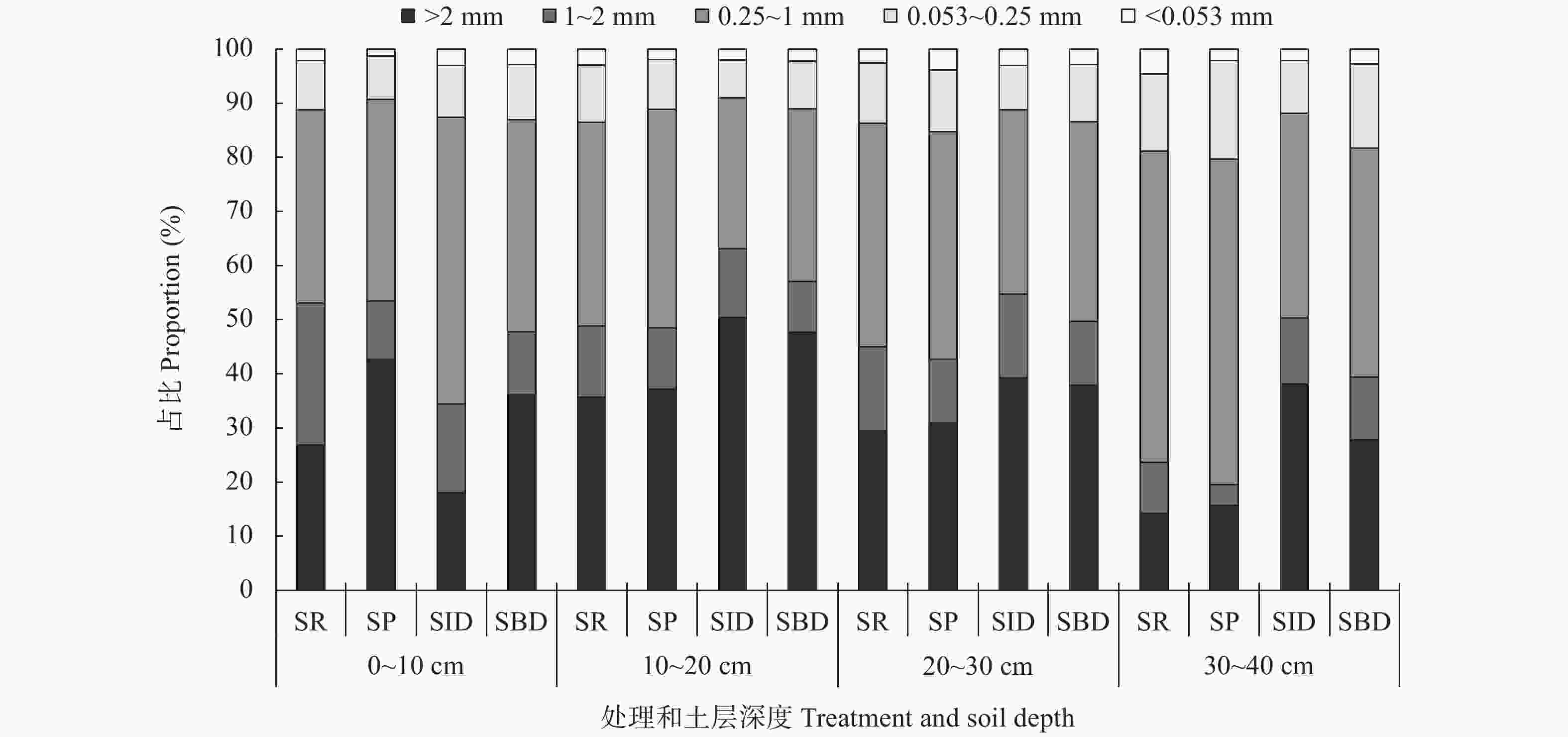
图2耕作与秸秆还田方式对土壤水稳性团聚体组成的影响
SR: 秸秆还田、土壤旋耕; SP: 秸秆还田、土壤深耕; SID: 秸秆集中深混埋至非种植带(40 cm宽)的0~40 cm土层; SBD: 秸秆集中深埋至30~40 cm土层。SR: straw mulching and rotary tillage; SP: straw mulching and deep ploughing; SID: straw incorporated into 0?40 cm layer of 40 cm wide no-wheat planting belt; SBD: straw buried into 30?40 cm soil layer.
Figure2.Effects of tillage and straw returning methods on soil water-stable aggregate composition
 下载: 全尺寸图片幻灯片
下载: 全尺寸图片幻灯片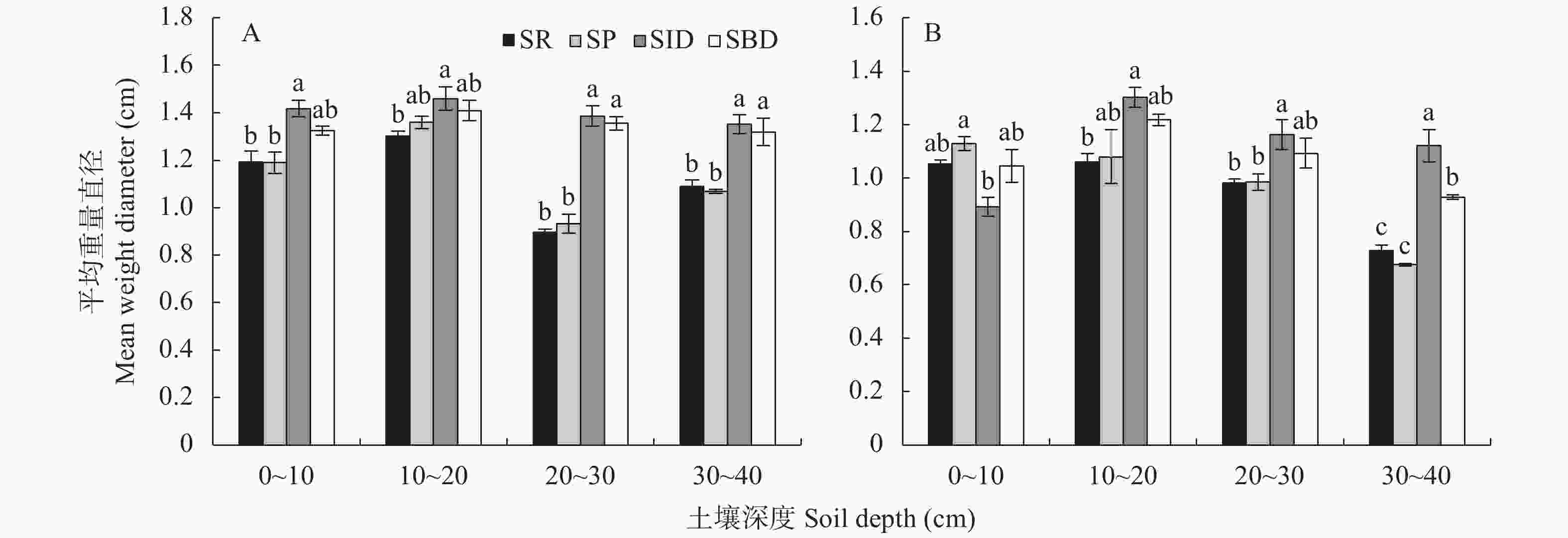
图3耕作与秸秆还田方式对土壤机械稳定性(A)和水稳性(B)团聚体平均重量直径的影响
SR: 秸秆还田、土壤旋耕; SP: 秸秆还田、土壤深耕; SID: 秸秆集中深混埋至非种植带(40 cm宽)的0~40 cm土层; SBD: 秸秆集中深埋至30~40 cm土层。同一土层不同小写字母表示处理间差异显著(P<0.05)。SR: straw mulching and rotary tillage; SP: straw mulching and deep ploughing; SID: straw incorporated into 0?40 cm layer of 40 cm wide no-wheat planting belt; SBD: straw buried into 30?40 cm soil layer. Different lowercase letters in the same soil layer indicate significant differences among treatments at P<0.05 level.
Figure3.Effect of tillage and straw returning methods on the mean weight diameter of soil mechanically stable (A) and water stable (B) aggregates
 下载: 全尺寸图片幻灯片
下载: 全尺寸图片幻灯片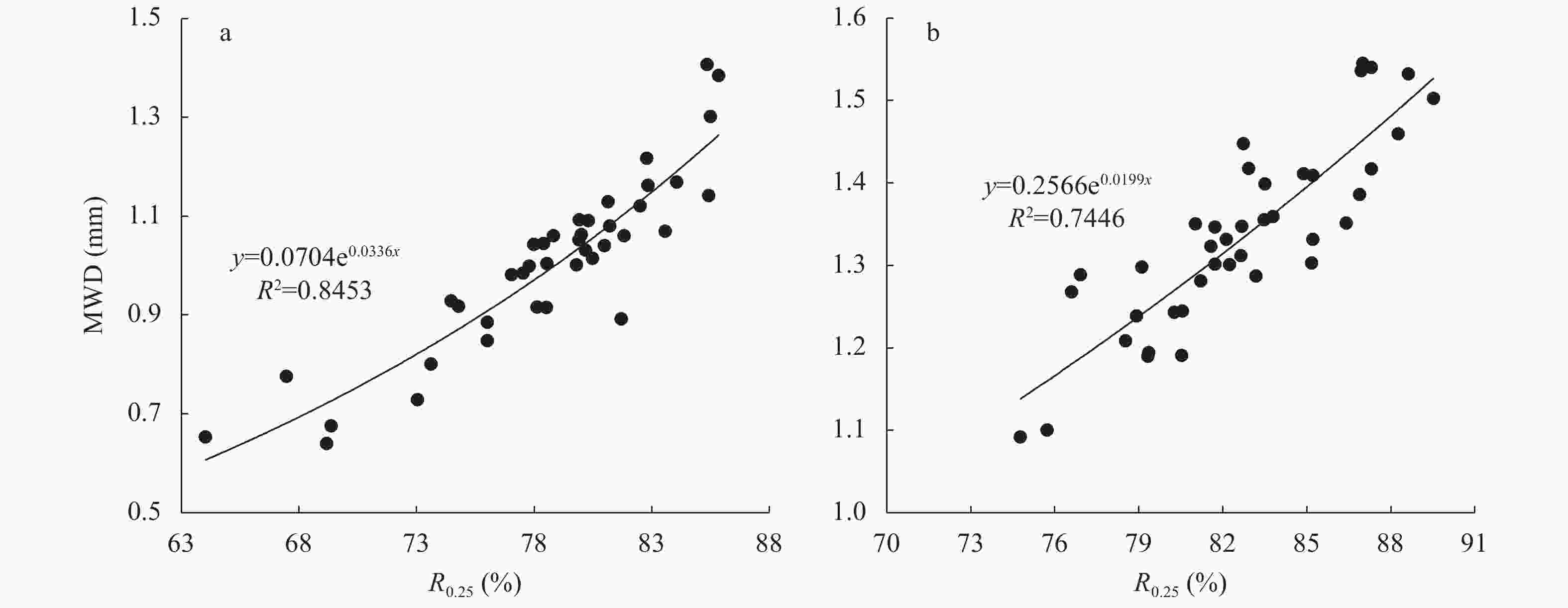
图4土壤粒径>0.25 mm水稳性(a)和机械稳定性(b)团聚体含量(R0.25)与团聚体平均重量直径(MWD)间的关系
Figure4.Relationship between mean weight diameter of soil aggregates (MWD) and contents of water stable (a) and mechanically stable (b) soil aggregates with >0.25 mm size (R0.25)
 下载: 全尺寸图片幻灯片
下载: 全尺寸图片幻灯片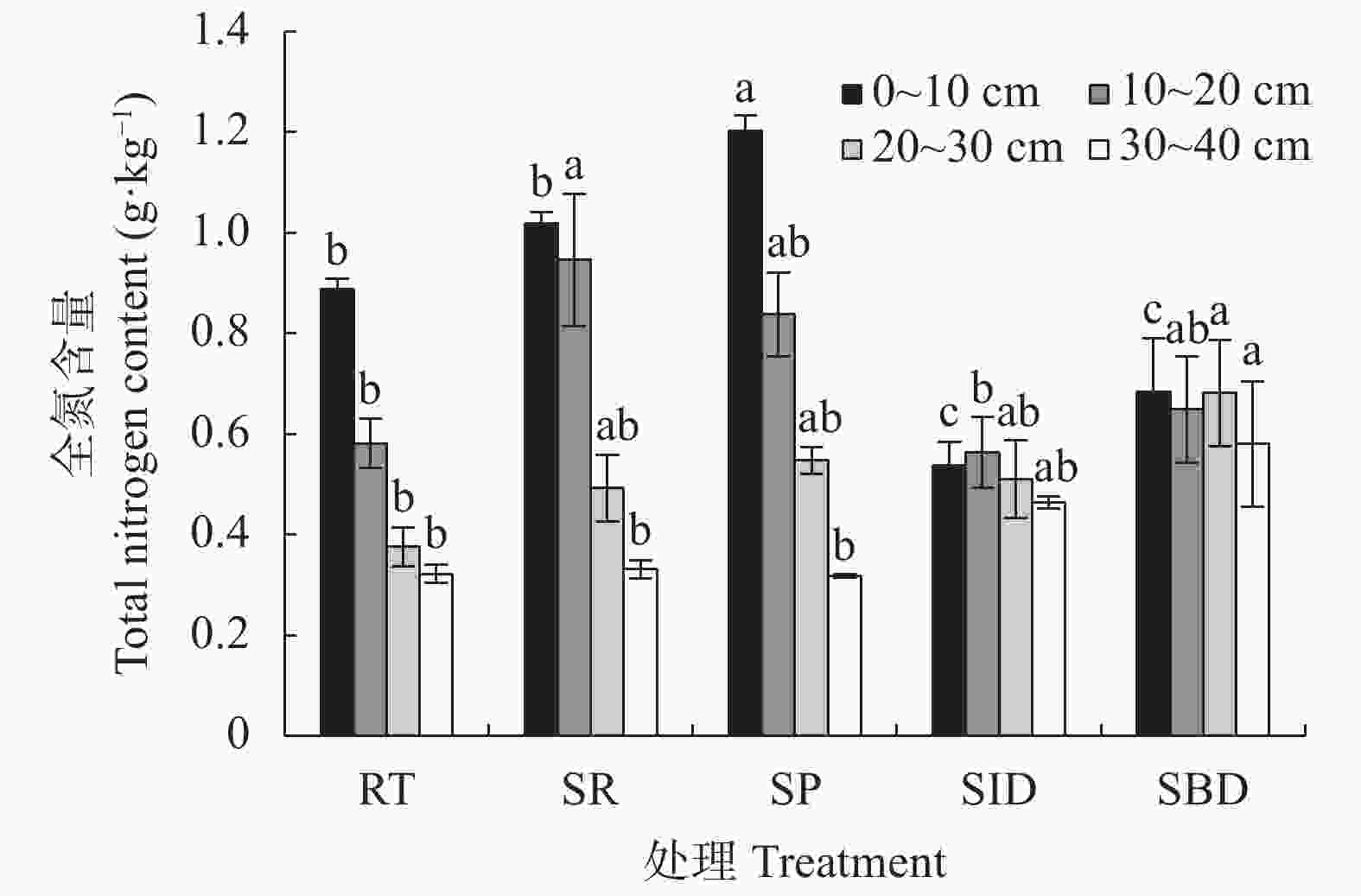
图5耕作与秸秆还田方式对氮素在耕层土壤垂向分布的影响
RT: 旋耕, 无秸秆还田; SR: 秸秆还田、土壤旋耕; SP: 秸秆还田, 土壤深耕; SID: 秸秆集中深混埋至非种植带(40 cm宽)的0~40 cm土层; SBD: 秸秆集中深埋至30~40 cm土层。同一土层不同小写字母表示处理间差异显著(P<0.05)。RT: rotary tillage without straw returning; SR: straw mulching and rotary tillage; SP: straw mulching and deep ploughing; SID: straw incorporated into 0?40 cm layer of 40 cm wide no-wheat planting belt; SBD: straw buried into 30?40 cm soil layer. Different lowercase letters in the same soil layer indicate significant differences among treatments at P<0.05 level.
Figure5.Effects of tillage and straw returning methods on vertical distribution of nitrogen in plough soil layer
 下载: 全尺寸图片幻灯片
下载: 全尺寸图片幻灯片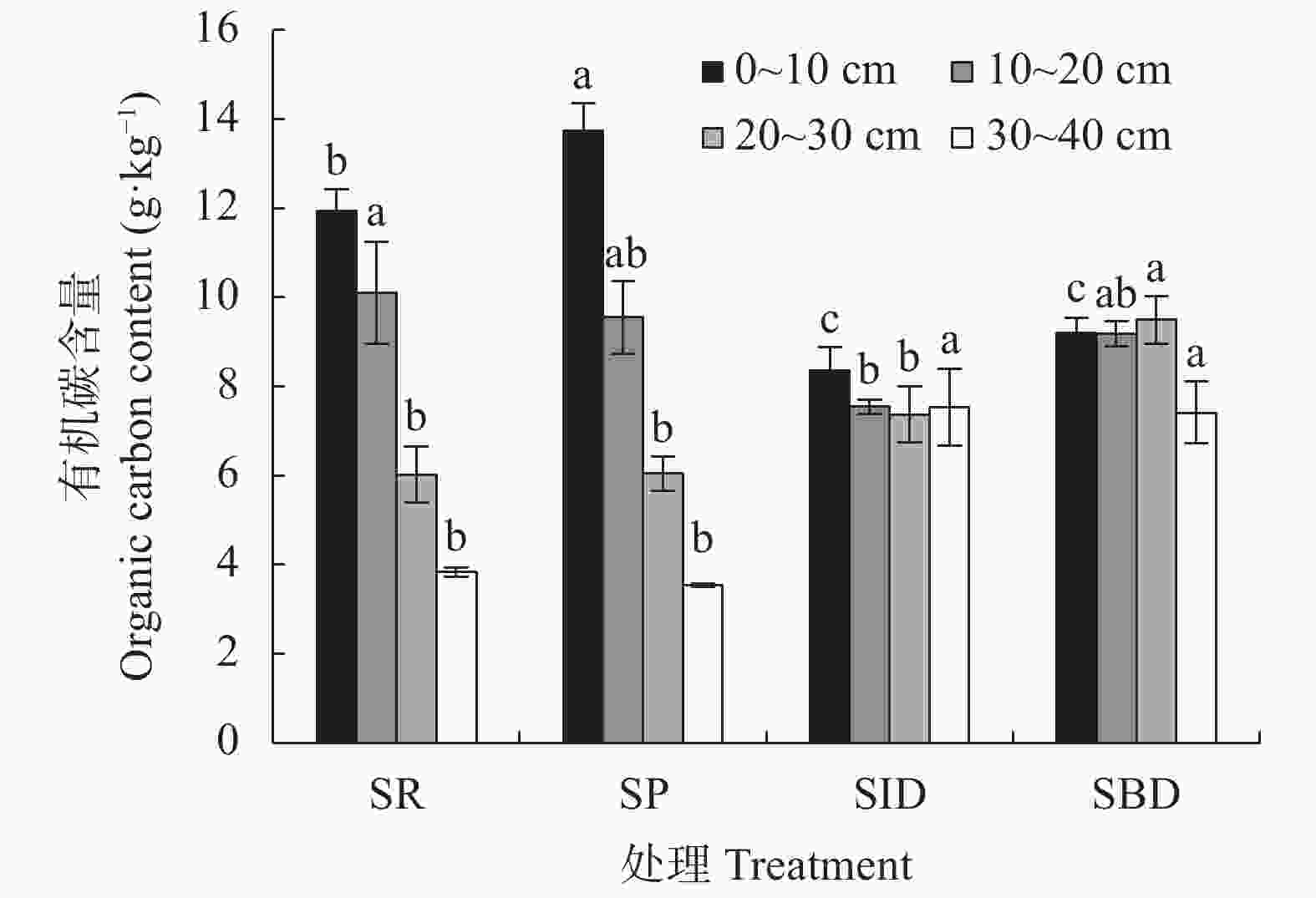
图6耕作与秸秆还田方式对有机碳在耕层土壤垂向分布的影响
SR: 秸秆还田、土壤旋耕; SP: 秸秆还田、土壤深耕; SID: 秸秆集中深混埋至非种植带(40 cm宽)的0~40 cm土层; SBD: 秸秆集中深埋至30~40 cm土层。同一土层不同小写字母表示处理间差异显著(P<0.05)。SR: straw mulching and rotary tillage; SP: straw mulching and deep ploughing; SID: straw incorporated into 0?40 cm layer of 40 cm wide no-wheat planting belt; SBD: straw buried into 30?40 cm soil layer. Different lowercase letters in the same soil layer indicate significant differences among treatments at P<0.05 level.
Figure6.Effects of tillage and straw returning methods on vertical distribution of organic carbon in plough soil layer
 下载: 全尺寸图片幻灯片
下载: 全尺寸图片幻灯片表1不同耕作与秸秆还田方式下土壤团聚体的破碎率和稳定率
Table1.Fragmentation rates and stability rates of soil aggregates with different sizes under different tillage and straw returning methods
| 深度 Soil depth (cm) | 处理 Treatment | 结构破碎率 Fragmentation rate (%) | 团聚体稳定率 Stability rate (%) | |||||
| >2 mm | 1~2 mm | 0.25~1 mm | >2 mm | 1~2 mm | 0.25~1 mm | |||
| 0~10 | SR | 32.5±4.0b | ?19.2±0.7d | ?28.7±1.1a | 67.5±5.4b | 119.2±9.2a | 128.7±12.7c | |
| SP | 1.9±0.4c | 52.2±2.3a | ?43.2±2.5a | 98.1±2.7a | 47.8±0.4c | 143.2±11.1c | ||
| SID | 65.9±3.2a | 24.4±1.4c | ?181.3±9.7c | 34.1±4.2c | 75.6±5.5b | 281.3±12.9a | ||
| SBD | 30.3±1.9b | 39.3±2.2b | ?101.2±2.2b | 69.7±2.5b | 60.7±3.8bc | 201.2±20.6b | ||
| 10~20 | SR | 26.5±2.0a | 35.4±1.6c | ?81.0±1.1b | 73.5±2.6b | 64.6±7.7a | 181.0±1.5a | |
| SP | 28.8±0.6a | 43.6±0.3b | ?108.6±5.7c | 71.2±0.8b | 56.4±8.0ab | 208.6±34.2a | ||
| SID | 11.8±0.2b | 33.4±0.9c | ?57.5±1.6a | 88.2±0.2a | 66.6±5.9a | 157.5±12.5a | ||
| SBD | 13.4±1.0b | 51.1±1.9a | ?83.8±2.5b | 86.6±1.3a | 48.9±4.2b | 183.8±28.1a | ||
| 20~30 | SR | 45.3±1.0a | 18.7±0.1b | ?110.9±0.9b | 54.7±1.3b | 81.3±0.1a | 210.9±1.2a | |
| SP | 47.0±4.3a | 24.5±1.5b | ?141.7±6.8c | 53.0±5.7b | 75.5±11.4ab | 241.7±9.1a | ||
| SID | 24.0±1.2b | 23.1±2.4b | ?60.0±3.3a | 76.0±3.4a | 76.9±7.7ab | 160.0±34.9a | ||
| SBD | 26.2±1.0b | 41.3±1.5a | ?94.6±3.8b | 73.8±1.8a | 58.7±5.1b | 194.6±35.6a | ||
| 30~40 | SR | 73.8±1.7a | 47.2±4.1b | ?210.9±13.7c | 26.2±2.3c | 52.8±5.4a | 310.9±18.3a | |
| SP | 70.4±0.5a | 77.9±1.9a | ?235.0±5.3c | 29.6±0.7c | 22.1±2.5b | 335.0±7.1a | ||
| SID | 21.9±1.7c | 40.4±2.7b | ?64.2±5.8a | 78.1±2.0a | 59.6±3.6a | 164.2±19.1b | ||
| SBD | 39.7±1.5b | 47.7±1.5b | ?101.4±3.4b | 60.3±3.8b | 52.3±1.8a | 201.4±34.6b | ||
| SR: 秸秆还田、土壤旋耕; SP: 秸秆还田、土壤深耕; SID: 秸秆集中深混埋至非种植带(40 cm宽)的0~40 cm土层; SBD: 秸秆集中深埋至30~40 cm土层。同一土层不同小写字母表示处理间差异显著(P<0.05)。SR: straw mulching and rotary tillage; SP: straw mulching and deep ploughing; SID: straw incorporated into 0?40 cm layer of 40 cm wide no-wheat planting belt; SBD: straw buried into 30?40 cm soil layer. Different lowercase letters in the same soil layer indicate significant differences among treatments at P<0.05 level. | ||||||||
 下载: 导出CSV
下载: 导出CSV表2耕作与秸秆还田方式对土壤团聚体氮素分布的影响
Table2.Effects of tillage and straw returning methods on nitrogen contents of soil aggregates with different sizes
| 土层深度 Soil depth (cm) | 处理 Treatment | 团聚体全氮含量 Nitrogen content in soil aggregates (g?kg?1) | ||||
| > 2 mm | 1~2 mm | 0.25~1 mm | 0.053~0.25 mm | < 0.053 mm | ||
| 0~10 | RT | 0.85±0.02ab | 0.84±0.02b | 0.85±0.03b | 0.72±0.03b | 1.29±0.21b |
| SR | 0.99±0.13a | 0.91±0.10b | 0.91±0.10ab | 0.76±0.06ab | 1.27±0.17b | |
| SP | 1.08±0.02a | 1.16±0.07a | 1.14±0.08a | 0.93±0.03a | 2.01±0.27a | |
| SID | 0.61±0.03bc | 0.58±0.01c | 0.53±0.01c | 0.44±0.02c | 0.74±0.03bc | |
| SBD | 0.53±0.12c | 0.49±0.11c | 0.47±0.10c | 0.36±0.10c | 0.53±0.19c | |
| 10~20 | RT | 0.59±0.02ab | 0.58±0.01bc | 0.54±0.01bc | 0.47±0.02a | 0.65±0.05ab |
| SR | 0.82±0.15a | 0.93±0.12a | 0.87±0.11a | 0.75±0.09a | 1.07±0.18a | |
| SP | 0.81±0.05a | 0.80±0.03ab | 0.74±0.08ab | 0.64±0.08a | 0.99±0.09ab | |
| SID | 0.60±0.04ab | 0.61±0.09bc | 0.57±0.06abc | 0.52±0.16a | 0.55±0.02b | |
| SBD | 0.45±0.15b | 0.39±0.15c | 0.38±0.15c | 0.43±0.16a | 0.54±0.22b | |
| 20~30 | RT | 0.49±0.03a | 0.42±0.03a | 0.39±0.03a | 0.34±0.02a | 0.53±0.09a |
| SR | 0.57±0.05a | 0.59±0.05a | 0.51±0.06a | 0.46±0.05a | 0.68±0.06a | |
| SP | 0.49±0.00a | 0.47±0.02a | 0.41±0.01a | 0.34±0.02a | 0.53±0.09a | |
| SID | 0.58±0.03a | 0.58±0.12a | 0.52±0.07a | 0.39±0.08a | 0.46±0.04a | |
| SBD | 0.56±0.22a | 0.50±0.22a | 0.47±0.19a | 0.50±0.20a | 0.60±0.27a | |
| 30~40 | RT | 0.40±0.02bc | 0.36±0.01bc | 0.33±0.01bc | 0.30±0.01c | 0.45±0.04b |
| SR | 0.48±0.07b | 0.43±0.03b | 0.35±0.03bc | 0.32±0.03bc | 0.44±0.04b | |
| SP | 0.29±0.01c | 0.26±0.01c | 0.21±0.01c | 0.41±0.01b | 0.41±0.01b | |
| SID | 0.45±0.01b | 0.46±0.01b | 0.38±0.02b | 0.32±0.02bc | 0.47±0.08b | |
| SBD | 0.72±0.03a | 0.68±0.09a | 0.56±0.10a | 0.51±0.06a | 0.79±0.12a | |
| RT: 旋耕, 无秸秆还田; SR: 秸秆还田、土壤旋耕; SP: 秸秆还田, 土壤深耕; SID: 秸秆集中深混埋至非种植带(40 cm宽)的0~40 cm土层; SBD: 秸秆集中深埋至30~40 cm土层。同一土层不同小写字母表示处理间差异显著(P<0.05)。RT: rotary tillage without straw returning; SR: straw mulching and rotary tillage; SP: straw mulching and deep ploughing; SID: straw incorporated into 0?40 cm layer of 40 cm wide no-wheat planting belt; SBD: straw buried into 30?40 cm soil layer. Different lowercase letters in the same soil layer indicate significant differences among treatments at P<0.05 level. | ||||||
 下载: 导出CSV
下载: 导出CSV表3耕作与秸秆还田方式对土壤团聚体全氮贡献率的影响
Table3.Contribution rates of soil aggregates with different sizes to soil nitrogen under tillage and straw returning methods
| 土层深度 Soil depth (cm) | 处理 Treatment | 团聚体全氮相对贡献率 Relative contribution rate of soil aggregate to soil nitrogen (%) | ||||
| > 2 mm | 1~2 mm | 0.25~1 mm | 0.053~0.25 mm | < 0.053 mm | ||
| 0~10 | RT | 54.1±6.5a | 9.6±1.8b | 18.0±2.9b | 4.5±0.5a | 8.8±2.9a |
| SR | 23.7±3.8bc | 20.9±1.5a | 29.1±5.0b | 6.2±0.5a | 2.4±0.4b | |
| SP | 34.4±1.8b | 9.0±1.5b | 31.7±4.4b | 5.5±0.4a | 1.8±0.2b | |
| SID | 19.0±3.3c | 16.9±2.2a | 49.7±7.4a | 7.3±0.3a | 3.8±0.4b | |
| SBD | 16.6±2.8c | 10.7±1.8b | 27.6±7.1b | 5.7±2.7a | 1.8±0.6b | |
| 10~20 | RT | 57.6±10.5a | 8.8±1.5a | 19.9±2.4a | 5.4±0.8a | 6.0±3.7a |
| SR | 28.1±3.6c | 11.9±1.5a | 31.9±0.4a | 7.7±0.5a | 3.0±0.4a | |
| SP | 32.6±6.5bc | 9.8±1.1a | 33.8±10.9a | 6.6±1.2a | 2.0±0.1a | |
| SID | 50.8±2.9ab | 12.8±2.8a | 26.5±2.7a | 5.9±1.4a | 1.9±0.5a | |
| SBD | 23.4±4.4c | 9.3±3.4a | 16.9±6.2a | 5.5±1.8a | 1.8±0.6a | |
| 20~30 | RT | 45.6±10.2a | 8.5±1.2b | 37.3±5.0a | 11.7±2.5a | 7.7±4.5a |
| SR | 31.2±2.6a | 16.7±1.6a | 38.7±3.4a | 9.5±1.4ab | 3.2±0.3a | |
| SP | 25.2±2.3a | 9.3±3.0b | 28.7±0.4ab | 6.4±0.0ab | 2.9±1.3a | |
| SID | 43.3±7.3a | 15.8±2.0a | 32.5±4.3ab | 5.8±0.9b | 3.6±1.1a | |
| SBD | 27.1±8.4a | 9.3±3.3b | 20.0±6.9b | 6.1±2.3b | 2.0±0.8a | |
| 30~40 | RT | 22.3±5.5bc | 9.0±0.5a | 42.3±2.0ab | 16.6±0.3a | 10.1±0.9a |
| SR | 18.2±1.0c | 11.0±0.6a | 55.0±0.2a | 12.2±0.9ab | 5.4±0.2b | |
| SP | 12.2±0.1c | 2.6±0.0b | 33.9±0.0b | 10.4±0.1b | 2.3±0.0c | |
| SID | 56.5±24.5ab | 11.4±0.7a | 29.1±4.0b | 6.5±1.5b | 2.2±0.8c | |
| SBD | 38.6±7a | 11.9±1a | 38.2±8.0b | 12.0±3ab | 1.7±1c | |
| RT: 旋耕, 无秸秆还田; SR: 秸秆还田、土壤旋耕; SP: 秸秆还田, 土壤深耕; SID: 秸秆集中深混埋至非种植带(40 cm宽)的0~40 cm土层; SBD: 秸秆集中深埋至30~40 cm土层。同一土层不同小写字母表示处理间差异显著(P<0.05)。RT: rotary tillage without straw returning; SR: straw mulching and rotary tillage; SP: straw mulching and deep ploughing; SID: straw incorporated into 0?40 cm layer of 40 cm wide no-wheat planting belt; SBD: straw buried into 30?40 cm soil layer. Different lowercase letters in the same soil layer indicate significant differences among treatments at P<0.05 level. | ||||||
 下载: 导出CSV
下载: 导出CSV表4耕作与秸秆还田方式对土壤团聚体有机碳分布的影响
Table4.Effects of tillage and straw returning methods on organic carbon contents in soil aggregate with different sizes
| 土层深度 Soil depth (cm) | 处理 Treatment | 团聚体有机碳含量 Organic carbon content in soil aggregates (g?kg?1) | ||||
| > 2 mm | 1~2 mm | 0.25~1 mm | 0.053~0.25 mm | < 0.053 mm | ||
| 0~10 | SR | 13.0±0.7a | 12.2±0.4b | 12.0±0.2b | 10.8±0.4b | 10.6±0.4a |
| SP | 13.9±0.8a | 15.4±0.1a | 14.5±1.0a | 12.9±1.0a | 12.3±0.9a | |
| SID | 9.1±0.1b | 8.7±0.2d | 7.3±0.2d | 6.0±0.2c | 7.5±0.6b | |
| SBD | 10.4±0.6b | 9.9±0.4c | 9.1±0.1c | 7.4±0.3c | 7.7±0.2b | |
| 10~20 | SR | 10.9±1.1a | 11.5±1.3a | 10.4±1.0a | 9.6±1.1a | 9.6±1.1a |
| SP | 10.6±0.9a | 11.1±0.7a | 10.1±1.1a | 9.2±1.2a | 8.8±0.8ab | |
| SID | 8.9±0.7a | 9.2±1.1a | 8.0±0.9a | 6.3±0.4b | 6.5±0.7b | |
| SBD | 9.3±0.2a | 9.4±0.2a | 8.7±0.3a | 7.5±0.2ab | 6.6±0.6b | |
| 20~30 | SR | 7.0±0.6b | 6.8±0.6b | 6.2±0.6b | 5.5±0.5b | 6.1±0.7a |
| SP | 7.3±0.2b | 7.2±0.3b | 6.2±0.3b | 5.4±0.3b | 5.9±0.5a | |
| SID | 8.8±0.5a | 8.6±0.8ab | 7.4±0.3b | 5.9±0.4b | 6.0±0.3a | |
| SBD | 10.1±0.2a | 10.0±0.8a | 9.1±0.5a | 7.9±0.3a | 7.4±0.2a | |
| 30~40 | SR | 6.1±0.9bc | 5.6±0.5b | 4.2±0.2b | 3.9±0.2b | 4.2±0.2bc |
| SP | 4.8±0.0c | 4.8±0.0b | 4.0±0.0b | 3.6±0.0b | 3.9±0.0c | |
| SID | 8.0±0.8ab | 8.3±1.0a | 7.3±1.2a | 5.5±0.4a | 5.3±0.3ab | |
| SBD | 9.8±0.4a | 9.8±0.4a | 7.6±0.6a | 5.8±0.7a | 6.3±0.6a | |
| SR: 秸秆还田、土壤旋耕; SP: 秸秆还田、土壤深耕; SID: 秸秆集中深混埋至非种植带(40 cm宽)的0~40 cm土层; SBD: 秸秆集中深埋至30~40 cm土层。同一土层不同小写字母表示处理间差异显著(P<0.05)。SR: straw mulching and rotary tillage; SP: straw mulching and deep ploughing; SID: straw incorporated into 0?40 cm layer of 40 cm wide no-wheat planting belt; SBD: straw buried into 30?40 cm soil layer. Different lowercase letters in the same soil layer indicate significant differences among treatments at P<0.05 level. | ||||||
 下载: 导出CSV
下载: 导出CSV表5耕作与秸秆还田方式对土壤团聚体有机碳贡献率的影响
Table5.Contribution rates of soil aggregates with different sizes to soil organic carbon
| 土层深度 Soil depth (cm) | 处理 Treatment | 团聚体有机碳相对贡献率 Relative contribution rate of soil aggregate to soil organic carbon | ||||
| > 2 mm | 1~2 mm | 0.25~1 mm | 0.053~0.25 mm | < 0.053 mm | ||
| 0~10 | SR | 29.4±2.4b | 26.8±1.1a | 36.0±2.7a | 8.3±0.2a | 1.9±0.2ab |
| SP | 43.2±2.7a | 11.9±2.5c | 39.1±3.4a | 7.6±0.9a | 1.2±0.3b | |
| SID | 19.3±3.2b | 17.1±0.4bc | 47.4±7.1a | 7.0±0.7a | 2.8±0.8a | |
| SBD | 28.2±5.3b | 18.6±2.6b | 43.3±4.5a | 8.8±2.3a | 2.2±0.1ab | |
| 10~20 | SR | 38.4±0.2a | 15.0±1.8a | 39.0±1.3a | 10.0±0.5a | 2.9±0.5a |
| SP | 41.8±10.4a | 13.2±2.2a | 41.9±9.7a | 8.8±0.5a | 1.7±0.3b | |
| SID | 59.6±8.7a | 14.7±2.3a | 29.3±3.2a | 5.8±0.6b | 1.7±0.3b | |
| SBD | 39.9±2.4a | 17.3±1.1a | 30.2±0.8a | 8.0±0.8a | 1.8±0.2b | |
| 20~30 | SR | 34.5±0.2b | 17.5±0.2a | 42.4±0.3a | 10.3±1.0a | 2.6±0.0a |
| SP | 37.1±2.4b | 14.2±2.8a | 43.5±0.4a | 10.2±0.2a | 3.6±1.2a | |
| SID | 47.6±5.4a | 17.7±1.7a | 34.4±4.7ab | 6.7±1.3b | 2.5±0.6a | |
| SBD | 42.3±1.1ab | 16.3±0.7a | 31.1±2.9b | 8.0±0.4ab | 2.1±0.2a | |
| 30~40 | SR | 22.3±3.1b | 13.5±1.5a | 63.4±3.2a | 14.4±1.3ab | 5.0±0.6a |
| SP | 21.2±0.1b | 5.2±0.1b | 68.4±0.6a | 18.8±0.6a | 2.3±0.1b | |
| SID | 40.4±4.6a | 13.4±0.1a | 36.5±3.7b | 7.3±1.3c | 1.5±0.4b | |
| SBD | 42.1±3.1a | 14.4±1.4a | 42.0±2.3b | 10.4±2.0bc | 2.1±0.7b | |
| SR: 秸秆还田、土壤旋耕; SP: 秸秆还田、土壤深耕; SID: 秸秆集中深混埋至非种植带(40 cm宽)的0~40 cm土层; SBD: 秸秆集中深埋至30~40 cm土层。同一土层不同小写字母表示处理间差异显著水平(P<0.05)。SR: straw mulching and rotary tillage; SP: straw mulching and deep ploughing; SID: straw incorporated into 0?40 cm layer of 40 cm wide no-wheat planting belt; SBD: straw buried into 30?40 cm soil layer. Different lowercase letters in the same soil layer indicate significant differences among treatments at P<0.05 level. | ||||||
 下载: 导出CSV
下载: 导出CSV参考文献
| [1] | LAL R. Physical management of soils of the tropics: priorities for the 21st century[J]. Soil Science, 2000, 165(3): 191?207 doi: 10.1097/00010694-200003000-00002 |
| [2] | 赵京考, 刘作新, 韩永俊. 土壤团聚体的形成与分散及其在农业生产上的应用[J]. 水土保持学报, 2003, 17(6): 163?166 doi: 10.3321/j.issn:1009-2242.2003.06.044 ZHAO J K, LIU Z X, HAN Y J. Review on formation and dispersion of aggregates and their application in agriculture[J]. Journal of Soil Water Conservation, 2003, 17(6): 163?166 doi: 10.3321/j.issn:1009-2242.2003.06.044 |
| [3] | 程乙, 任昊, 刘鹏, 等. 不同栽培管理模式对农田土壤团聚体组成及其碳、氮分布的影响[J]. 应用生态学报, 2016, 27(11): 3521?3528 CHENG Y, REN H, LIU P, et al. Effects of different cultiva-tion practices on composition, carbon and nitrogen distribution of soil aggregates in farmlands[J]. Chinese Journal of Applied Ecology, 2016, 27(11): 3521?3528 |
| [4] | 贺美, 王迎春, 王立刚, 等. 应用DNDC模型分析东北黑土有机碳演变规律及其与作物产量之间的协同关系[J]. 植物营养与肥料学报, 2017, 23(1): 9?19 doi: 10.11674/zwyf.16146 HE M, WANG Y C, WANG L G, et al. Using DNDC model to simulate black soil organic carbon dynamics as well as its coordinate relationship with crop yield[J]. Journal of Plant Nutrition and Fertilizer, 2017, 23(1): 9?19 doi: 10.11674/zwyf.16146 |
| [5] | 张家春, 刘盈盈, 贺红早, 等. 土壤团聚体与有机碳固定关系研究进展[J]. 福建农业学报, 2016, 31(3): 319?325 ZHANG J C, LIU Y Y, HE H Z, et al. Research advances on mechanism of organic carbon sequestration in soil aggre-gates[J]. Fujian Journal of Agricultural Sciences, 2016, 31(3): 319?325 |
| [6] | 田慎重, 王瑜, 张玉凤, 等. 旋耕转深松和秸秆还田增加农田土壤团聚体碳库[J]. 农业工程学报, 2017, 33(24): 133?140 doi: 10.11975/j.issn.1002-6819.2017.24.018 TIAN S Z, WANG Y, ZHANG Y F, et al. Residue returning with subsoiling replacing rotary tillage improving aggregate and associated carbon[J]. Transactions of the Chinese Society of Agricultural Engineering, 2017, 33(24): 133?140 doi: 10.11975/j.issn.1002-6819.2017.24.018 |
| [7] | PRASAD J V N S, RAO C S, SRINIVAS K, et al. Effect of ten years of reduced tillage and recycling of organic matter on crop yields, soil organic carbon and its fractions in Alfisols of semi arid tropics of southern India[J]. Soil and Tillage Research, 2016, 156: 131?139 doi: 10.1016/j.still.2015.10.013 |
| [8] | 刘恩科, 赵秉强, 梅旭荣, 等. 不同施肥处理对土壤水稳定性团聚体及有机碳分布的影响[J]. 生态学报, 2010, 30(4): 1035?1041 LIU E K, ZHAO B Q, MEI X R, et al. Distribution of water-stable aggregates and organic carbon of arable soils affected by different fertilizer application[J]. Acta Ecologica Sinica, 2010, 30(4): 1035?1041 |
| [9] | 王富华, 黄容, 高明, 等. 生物质炭与秸秆配施对紫色土团聚体中有机碳含量的影响[J]. 土壤学报, 2019, 56(4): 929?939 doi: 10.11766/trxb201805020169 WANG F H, HUANG R, GAO M, et al. Effect of combined application of biochar and straw on organic carbon content in purple soil aggregates[J]. Acta Pedologica Sinica, 2019, 56(4): 929?939 doi: 10.11766/trxb201805020169 |
| [10] | 石彦琴, 陈源泉, 隋鹏, 等. 农田土壤紧实的发生、影响及其改良[J]. 生态学杂志, 2010, 29(10): 2057?2064 SHI Y Q, CHEN Y Q, SUI P, et al. Cropland soil compaction: Its causes, influences, and improvement[J]. Chinese Journal of Ecology, 2010, 29(10): 2057?2064 |
| [11] | 孙国峰, 张海林, 徐尚起, 等. 轮耕对双季稻田土壤结构及水贮量的影响[J]. 农业工程学报, 2010, 26(9): 66?71 doi: 10.3969/j.issn.1002-6819.2010.09.011 SUN G F, ZHANG H L, XU S Q, et al. Effects of rotational tillage treatments on soil structure and water storage in double rice cropping region[J]. Transactions of the Chinese Society of Agricultural Engineering, 2010, 26(9): 66?71 doi: 10.3969/j.issn.1002-6819.2010.09.011 |
| [12] | 聂良鹏, 郭利伟, 牛海燕, 等. 轮耕对小麦–玉米两熟农田耕层构造及作物产量与品质的影响[J]. 作物学报, 2015, 41(3): 468?478 doi: 10.3724/SP.J.1006.2015.00468 NIE L P, GUO L W, NIU H Y, et al. Effects of rotational tillage on tilth soil structure and crop yield and quality in maize-wheat cropping system[J]. Acta Agronomica Sinica, 2015, 41(3): 468?478 doi: 10.3724/SP.J.1006.2015.00468 |
| [13] | 李荣, 侯贤清, 贾志宽, 等. 北方旱作区土壤轮耕技术研究进展[J]. 西北农业学报, 2015, 24(3): 1?7 doi: 10.7606/j.issn.1004-1389.2015.03.001 LI R, HOU X Q, JIA Z K, et al. Research advance in soil ro-tational tillage on dry farming areas in Northern China[J]. Acta Agriculturae Boreali-Occidentalis Sinica, 2015, 24(3): 1?7 doi: 10.7606/j.issn.1004-1389.2015.03.001 |
| [14] | 孔凡磊, 陈阜, 张海林, 等. 轮耕对土壤物理性状和冬小麦产量的影响[J]. 农业工程学报, 2010, 26(8): 150?155 doi: 10.3969/j.issn.1002-6819.2010.08.026 KONG F L, CHEN F, ZHANG H L, et al. Effects of rotational tillage on soil physical properties and winter wheat yield[J]. Transactions of the Chinese Society of Agricultural Engineering, 2010, 26(8): 150?155 doi: 10.3969/j.issn.1002-6819.2010.08.026 |
| [15] | 侯贤清, 贾志宽, 韩清芳, 等. 不同轮耕模式对旱地土壤结构及入渗蓄水特性的影响[J]. 农业工程学报, 2012, 28(5): 85?94 doi: 10.3969/j.issn.1002-6819.2012.05.015 HOU X Q, JIA Z K, HAN Q F, et al. Effects of different rotational tillage patterns on soil structure, infiltration and water storage characteristics in dryland[J]. Transactions of the Chinese Society of Agricultural Engineering, 2012, 28(5): 85?94 doi: 10.3969/j.issn.1002-6819.2012.05.015 |
| [16] | 田慎重, 宁堂原, 王瑜, 等. 不同耕作方式和秸秆还田对麦田土壤有机碳含量的影响[J]. 应用生态学报, 2010, 21(2): 373?378 TIAN S Z, NING T Y, WANG Y, et al. Effects of different tillage methods and straw-returning on soil organic carbon content in a winter wheat field[J]. Chinese Journal of Applied Ecology, 2010, 21(2): 373?378 |
| [17] | 秦红灵, 高旺盛, 马月存, 等. 两年免耕后深松对土壤水分的影响[J]. 中国农业科学, 2008, 41(1): 78?85 doi: 10.3864/j.issn.0578-1752.2008.01.010 QIN H L, GAO W S, MA Y C, et al. Effects of subsoiling on soil moisture under no-tillage 2 years later[J]. Scientia Agri-cultura Sinica, 2008, 41(1): 78?85 doi: 10.3864/j.issn.0578-1752.2008.01.010 |
| [18] | SIX J, ELLIOTT E T, PAUSTIAN K, et al. Aggregation and soil organic matter accumulation in cultivated and native grassland soils[J]. Soil Science Society of America Journal, 1998, 62(5): 1367?1377 doi: 10.2136/sssaj1998.03615995006200050032x |
| [19] | CAMBARDELLA C A, ELLIOTT E T. Carbon and nitrogen distribution in aggregates from cultivated and native grass-land soils[J]. Soil Science Society of America Journal, 1993, 57(4): 1071?1076 doi: 10.2136/sssaj1993.03615995005700040032x |
| [20] | EYNARD A, SCHUMACHER T E, LINDSTROM M J, et al. Aggregate sizes and stability in cultivated south Dakota prairie ustolls and usterts[J]. Soil Science Society of America Journal, 2004, 68: 1360?1365 doi: 10.2136/sssaj2004.1360 |
| [21] | SODHI G P S, BERI V, BENBI D K. Soil aggregation and distribution of carbon and nitrogen in different fractions under long-term application of compost in rice-wheat system[J]. Soil and Tillage Research, 2009, 103(2): 412?418 doi: 10.1016/j.still.2008.12.005 |
